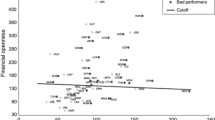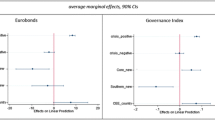Abstract
We employ cross-country variance tests using quarterly data over 2002–2013 to analyze the effect of the global financial crisis on euro area financial integration. Dividing the 12 core euro area countries into two groups, the euro center and the euro periphery, we investigate variances of the estimations across these two groups before and after the onset of financial crisis. We find a significant change in variances in a sample that includes both groups but no such change within just the euro center group. Using data for new euro area members, no significant changes in variances are found in these countries. Although the difference in variances appears to get smaller, financial integration within the euro area remains differentiated, with the center still holding.


Similar content being viewed by others
Notes
The latter turned out to be to a degree a red herring given that these countries, in contrast to their euro periphery neighbors, had accompanied borrowing with growth supporting reforms. Not surprisingly, where parent–subsidiary relations were long term, cross-border links would prove to be stable and the main threat to these countries came largely from Western Europe even if lessons needed to be drawn about managing external imbalances in an increasingly integrated European financial market (see Gill and Raiser, 2012).
The nationalization of Anglo Irish is treated as an important threshold in Mody and Sandri (2012), where the authors divide the period of euro area sovereign and banking crisis into three phases. The three phases are: (1) transmission of financial distress from the United States to Europe (from July 2007 to March 2008, which is marked by the rescue of Bear Stearns), (2) increasing stress on European governments due to public financial burden to bail out troubled banks (from March 2008 to January 2009, marked by the nationalization of Anglo Irish) and (3) intertwined financial and sovereign crisis strengthened after the Greece bailout in May 2010 (from January 2009).
The group of euro center countries comprises Austria, Belgium, Finland, France, Germany, Luxembourg and the Netherlands, and the euro periphery includes five countries that have faced market access difficulties since the global financial crisis – Greece, Ireland, Italy, Portugal and Spain.
The similar argument in the context of emerging market economies can be found in Kose et al. (2009).
See Table A1 in Appendix for the estimation results.
This methodological framework is similar to the idea of coefficient stability test, in a sense that the analysis is based on two sub-samples in a time dimension and that both tests look at equality of estimated results from the two sub-periods. However, unlike the test for coefficient stability, in the variance test estimation of two sub-periods can be carried out in a single equation by allowing for different coefficients before and after the event. As another example of examining difference in the trends before and after an event, Eichengreen and Mody (2000) decompose factors that explain the change in spreads between two periods into two contributing parts: contributions of the change in observed economic fundamentals and the change in market sentiment.
The ratings regression is also estimated using OLS.
See Dell’Ariccia et al. (2002) and IMF (2007) for the statistical details of variance tests.
Global factors (eg, US interest rate) can asymmetrically affect individual countries, depending on the degree of integration to the world. Similarly, country-specific factors can have region-wide effects (eg, the impact of fiscal imbalance in Italy on other euro area members’ bond yield spreads). Battistini et al. (2013) employ a dynamic factor model to take this relationship into account.
The data on consumer sentiment start in 2002Q1 for Luxembourg. Since lagged values are used for this variable, we use a value of 2002Q1 for 2001Q4. The same modification is done for Malta (2003Q1) used in the section ‘Alternative integration measures and euro east’.
Because of the data availability, Estonia is not included. Latvia is also excluded, since the country joined the euro area in January 2014.
For Tables 6 and 7, the complete tables (presented as in Table 5), including all the quarter-by-quarter test results, are available as a PDF Appendix on the journal’s website.
References
Antonakakis, N and Vergos, K . 2013: Sovereign bond yield spillovers in the euro zone during the financial and debt crisis. Journal of International Financial Markets, Institutions & Money 26: 258–272.
Baele, L, Ferrando, A, Hördahl, P, Krylova, E and Monnet, C . 2004: Measuring European financial integration. Oxford Review of Economic Policy 20 (4): 509–530.
Baltzer, M, Cappiello, L, De Santis, RA and Manganelli, S . 2008: Measuring financial integration in new EU member states. ECB Occasional Paper 81, European Central Bank: Frankfurt, Germany.
Battistini, N, Pagano, M and Simonelli, S . 2013: Systemic risk and home bias in the Euro area. European Economy Economic Papers 494, European Commission: Brussels, Belgium.
Beck, T, Feyen, E, Ize, A and Moizeszowicz, F . 2008: Benchmarking financial development. World Bank Policy Research Working Paper 4638, World Bank: Washington DC.
Bernoth, K, von Hagen, J and Schuknecht, L . 2012: Sovereign risk premiums in the European government bond market. Journal of International Money and Finance 31 (5): 975–995.
Caporale, GM, Matousek, R and Stewart, C . 2011: EU banks rating assessments: Is there heterogeneity between new and old member countries? Review of International Economics 19 (1): 189–206.
Codogno, L, Favero, C and Missale, A . 2003: Yield spreads on EMU government bonds. Economic Policy 18 (37): 503–532.
De Grauwe, P and Ji, Y . 2012: Mispricing of sovereign risk and macroeconomic stability in the eurozone. Journal of Common Market Studies 50 (6): 866–880.
Dell’Ariccia, G, Schnabel, I and Zettelmeyer, J . 2002: Moral hazard and international crisis lending: A test. IMF Working Paper 02/181, International Monetary Fund: Washington DC.
Ehrmann, M, Fratzscher, M, Gürkaynak, RS and Swanson, ET . 2011: Convergence and anchoring of yield curves in the euro area. The Review of Economics and Statistics 93 (1): 350–364.
Eichengreen, B and Mody, A . 2000: What explains changing spreads on emerging market debt? In: Edwards, S. (ed). Capital Flows and the Emerging Economies: Theory, Evidence, and Controversies. University of Chicago Press: Chicago, IL, pp. 107–136.
Eichengreen, B and Mody, A . 2001: Bail-Ins, bailouts, and borrowing costs. IMF Staff Papers 47 (Special Issue): 155–187.
European Central Bank (ECB). 2011: Financial integration in Europe. May. European Central Bank: Frankfurt, Germany.
European Central Bank (ECB). 2013: Financial integration in Europe. April. European Central Bank: Frankfurt, Germany.
Favero, C and Missale, A . 2012: Sovereign spreads in the eurozone: Which prospects for a eurobond? Economic Policy 27 (70): 231–273.
Gabrisch, H and Orlowski, LT . 2010: Interest rate convergence in Euro-candidate countries: Volatility dynamics of sovereign bond yields. Emerging Markets Finance and Trade 46 (6): 69–85.
Gill, I and Raiser, M . 2012: Golden growth: Restoring the lustre of the European economic model. With Dall’Olio, AM, Packard, T, Richter, K, Sugawara, N, Veugelers, R and Zalduendo, J. World Bank: Washington DC.
Hodrick, RJ and Prescott, EC . 1997: Postwar U.S. business cycles: An empirical investigation. Journal of Money, Credit and Banking 29 (1): 1–16.
Im, KS, Pesaran, MH and Shin, Y . 2003: Testing for unit roots in heterogeneous panels. Journal of Econometrics 115 (1): 53–74.
International Monetary Fund (IMF). 2007: Fund financial support and moral hazard: Analytics and empirics. Paper prepared by Ghosh, A, Kim, J, Rahman, L and Zalduendo, J. International Monetary Fund, Washington DC.
International Monetary Fund (IMF). 2008: Offshore financial centers: A report on the assessment program and proposal for integration with the financial sector assessment program. Report prepared by the Monetary and Capital Markets Department and the Legal Department, International Monetary Fund: Washington DC.
International Monetary Fund (IMF). 2012: Macroeconomic policy frameworks for resource-rich developing countries. Report prepared by an IMF staff team led by Ghura, D and Pattillo, C. International Monetary Fund: Washington DC.
Kalbaska, A and Gątkowski, M . 2012: Eurozone sovereign contagion: Evidence from the CDS market (2005–2010). Journal of Economic Behavior and Organization 83 (3): 657–673.
Kim, S and Lee, J-W . 2012: Real and financial integration in East Asia. Review of International Economics 20 (2): 332–349.
Kim, S-J, Lucey, BM and Wu, E . 2006: Dynamics of bond market integration between established and accession European union countries. Journal of International Financial Markets, Institutions and Money 16 (1): 41–56.
Kose, MA, Prasad, E, Rogoff, K and Wei, S-J . 2009: Financial globalization: A reappraisal. IMF Staff Papers 56 (1): 8–62.
Lee, H-H, Huh, H-S and Park, D . 2013: Financial integration in East Asia: An empirical investigation. The World Economy 36 (4): 396–418.
Maltritz, D . 2012: Determinants of sovereign yield spreads in the Eurozone: A Bayesian approach. Journal of International Money and Finance 31 (3): 657–672.
Manganelli, S and Wolswijk, G . 2009: What drives spreads in the Euro area government bond market? Economic Policy 24 (58): 191–240.
Melander, O, Pant, M, Segoviano, M and Vamvakidis, A . 2011: Dancing spreads: Market assessment of contagion from the crisis in the euro periphery based on distress dependence analysis. International Advanced in Economic Research 17 (3): 347–363.
Mink, M and de Haan, J . 2013: Contagion during the Greek sovereign debt crisis. Journal of International Money and Finance 34: 102–113.
Mody, A and Sandri, D . 2012: The Eurozone crisis: How banks and sovereigns came to be joined at the hip. Economic Policy 27 (70): 199–230.
Olivero, MP and Madak, R . 2013: Financial integration within Europe and the international transmission of business cycles among industrialized countries. Applied Economics 45 (1): 111–122.
Pagano, M and von Thadden, E-L . 2004: The European bond markets under EMU. Oxford Review of Economic Policy 20 (4): 531–554.
World Bank. 2012: Global financial development report 2013: Rethinking the role of the state in finance. World Bank: Washington DC.
Acknowledgements
The authors thank two anonymous referees and Paul Wachtel for helpful comments and suggestions. The findings, interpretations and views expressed in this article are entirely those of the authors and do not necessarily reflect those of the World Bank and the International Monetary Fund, their Executive Directors or the governments they represent.
Author information
Authors and Affiliations
Additional information
Supplementary information accompanies this paper on the Comparative Economic Studies website (www.palgrave-journals.com/ces)
Electronic supplementary material
Appendix
Rights and permissions
About this article
Cite this article
Gill, I., Sugawara, N. & Zalduendo, J. The Center Still Holds: Financial Integration in the Euro Area. Comp Econ Stud 56, 351–375 (2014). https://doi.org/10.1057/ces.2014.15
Published:
Issue Date:
DOI: https://doi.org/10.1057/ces.2014.15




